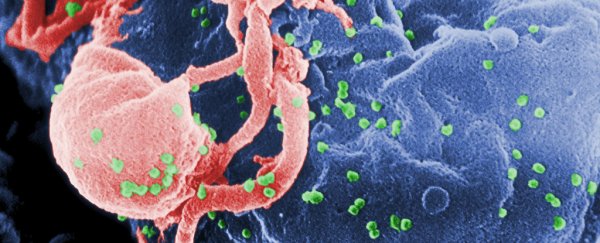Research has shown that our DNA houses the ghosts of viruses fended off by your ancestors, and some of those viruses could still be dangerous if they wake up. And now scientists just found more of them.
After surveying 2,500 human genomes, a team discovered evidence of 36 different viruses that had accumulated in there over the course of our evolution, including 19 that had never been found before, and one that might still be infectious if it was turned on.
So how does viral DNA get in our cells in the first place? To reproduce, viruses need to use your own DNA against you. They start by getting inside of your cells and shoving their genes in between yours. That way, when your cells make copies of their DNA - like they do when they're about to replicate - they make copies of the virus's genes, too.
The virus's genes then switch on once they're in the new cell and turn it into a virus-making factory. These new viruses go on to shove their genes into other cells, and the process repeats.
Eventually (hopefully), your body fights off the viruses that are floating around and infecting new cells, but it can't get rid of the bits of virus that are already stuck in your DNA. So it does the next-best thing and switches those bits of DNA off.
But once they're switched off, the segements of viral DNA don't go anywhere; they're just stuck in the middle of your genome, getting copied every time your cells divide. That means if some cells with altered genomes get passed on to your child, then the virus's genes get passed down the generations - switched off, but still potentially infectious.
These bits of DNA aren't doing anything, so mutations can accumulate in them without it having any real effects on how your body works, and eventually, all of these mutations make the DNA unable to switch back on and make an infectious virus, even if it wanted to.
But mutations or no mutations, these are bits of DNA that humans didn't evolve to have in there, so they can still cause other problems. For example, parts of the viral DNA can become activated and contribute to diseases, or they can just wreak havoc in the normal function of individual cells.
In their new study, a team led by Jeffrey Kidd of the University of Michigan and John Coffin of Tufts University found 18 of these mutants that had never been seen before. Some of them were pretty rare, appearing in only a couple of the 2,500 genomes surveyed. But others were widespread, popping up over 75 percent of the time.
Interestingly, the researchers also found one virus that was more intact. This happens when an infection is recent enough - or, by chance, the bits of DNA won't have mutated very much since it happened - and it means that the dormant DNA could still produce an infectious virus if it were turned back on.
As of last year, only one such protovirus, as it's known, had been discovered. Now we know of two.
Not much is known about the newly found protovirus, named Xq21.33 after its location on the X chromosome, and the teams are still working to see if they can figure out what kind of virus it came from and what the virus did. But what they do know is that it infected the ancestors of 44 of the people whose genomes were examined, and the team is confident that it has mutated so little since then that it could still be infectious today.
The researchers don't think there's much of a chance of this virus suddenly coming back to life, since our bodies have ways of keeping quiet the genes that it wants silenced. But still, it's disconcerting to think about the ghost of a virus our ancestors fought off coming back to haunt us.
The study has been published in the Proceedings of the National Academy of Sciences.
